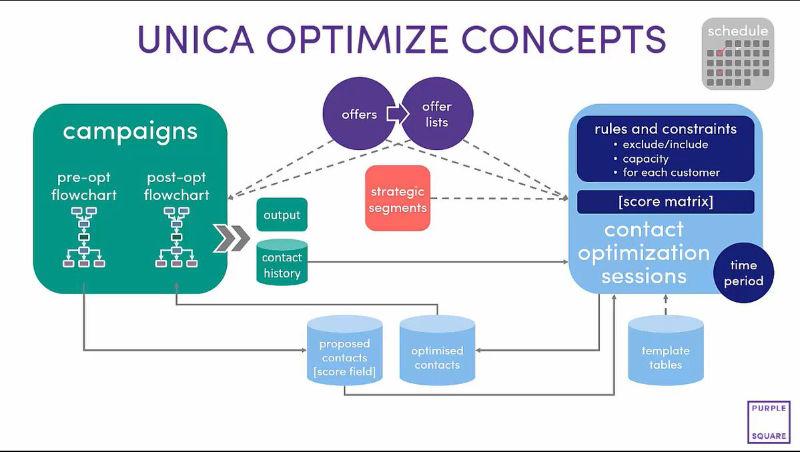Unica Optimize – optimising marketing campaigns for greater ROI
Marketers are constantly seeking ways to optimise their marketing campaigns to meet both customer and business requirements and there are many excellent tools on the market that exist to do just this. One of these is Unica Optimize, which allows organisations to optimise contacts across many different aspects of marketing automation, via scoring models.
If you’re a current Unica user, familiar with Campaign for example, understanding how Optimize can amplify your marketing efforts could be the essential next step in improving your ROI. From v12, Optimize integration with Campaign has been extended, even allowing you to run an optimisation session from within a flowchart. Or perhaps you’re considering a move to a platform that includes campaign optimisation? This article will talk you through how the Unica platform can assist you with determining optimal contact strategies.
How does Unica Optimize Work?

Unica Optimize considers the following aspects in campaign optimisation:
- Customer – make the best use of the limited time you get to speak to your customers
- Offer – find the best recipients for your offers when availability is limited
- Time – reduce conflict across a given time-period and minimise repetition
- Budget – Better manage budget allocation
- Channel Capacity – determine best channel for each customer
- Goal – score your data for improvements in revenue, profit, or response rate
Optimize allows the application of constraints and rules across your campaign, across a required time period to pick the optimum campaigns for both your customers and your business.
With Unica Optimize you can:
- Identify the most relevant offers for a customer, or customers for an offer
- Reduce contact fatigue
- Lower costs and increase revenue
- Build on established capability within Unica Campaign
So how does it all work? Let’s break down this quick process flow to understand what’s under the hood of Unica Optimize.
Proposed Contacts Table
At a high level, the process within a single campaign or across multiple ones, is to write data to a central location called the PCT or Proposed Contacts Table.
Optimize will then apply the rules you have configured across all of these contacts and offers to then create an optimised set of contacts. This is called an OCT or Optimised Contact Table.
These tables can then be accessed in a downstream process and used to contact your customers with the chosen offers, to the channels of your choice.
The Optimize Session
Central to the solution is an Optimize session. An Optimize session will deal with the rules to include or remove audience members (e.g. customer, account etc). You can include a template at this point which will provide a level of standardisation over which data values are expected for the optimisation. Flowcharts will write to the session from one or more campaigns.
Rules and Constraints
One of the main requirements of an Optimize session is to set up Rules and Constraints. These can be considered across your entire organisation, such as limits you must place on communication to help with capacity planning, or at an individual customer level, including consideration for fatigue rules.
Rules can be used to assess the outcomes for every customer individually, or across your organisation. They are defined conditions that eliminate possible alternatives in the data, providing a single solution. Some examples of Rules include:
- Min/Max # Offers for each customer – these can be applied to specific offers, segments or channels, across a defined time period
- Never A followed by B – this rule type prevents a customer who has received one offer from receiving another for a certain time period
- Never A with B – prevents a customer from receiving a pair of offers within a requested timeframe. Example Renewal Offer and Upgrade Offer.
- Max #Duplicate offers – how many times a customer can see a duplicate offer in a chosen time period
- Customers In – allows the inclusion or exclusion of customers a given strategic segment.
Constraints are typically Minimum/Maximum thresholds that cannot be exceeded and can help with scenarios including:
- The maximum number of calls your sales team can make in a week
- Available inventory control
- A customer requiring a minimum number of offers to populate a booklet
The Score Matrix
Once qualifying contacts are presented, it could be that a contact is still presented with too many offers or too many instances of an offer are present in the output.
The optimization algorithms can use scores for the contacts and offers to try to maximise the best possible result for the session. These would be generated through your own analytical research or predicative analytics, to optimise a session around your organisational goals including revenue or response rates.
They can either be written into the data itself as a score field in the Proposed Contacts Table or entered manually into the session via a score matrix.
Time Period
The optimization period for a session is the elapsed time between the earliest and latest proposed contact. This would be given by the range of proposed contact dates in the PCT. Example values might be a week or month.
If you want Optimize to apply rules around the number of contacts a customer receives during the time period then it would need to know about all the potential contacts that a customer would receive in that period in order to run the Optimisation Session.
This would normally mean a consideration around campaign scheduling, particularly if you are used to executing campaigns individually on an as-required basis.
Template Tables
To make the process of creating the Proposed Contacts Table easier, you can create a field requirement template and apply it to multiple campaign flowcharts. This is used to standardise the output process to a PCT by defining which fields are required for a particular optimisation session. The flowchart can then be used to map available flowchart data to required data fields.
Offers
Central to the optimization process, along with your selected audience, are the offers themselves.
Offers are marketing messages you can record in Unica Campaign for delivery to a customer. They are assigned to lists of IDs or target cells in Campaign flowcharts and allow you to track the contact and response events more easily, to and from your customers.
An offer list is a collection of offers. An example of an offer list would be a coupon booklet. There are two types of offer list available
- A Static list is a predefined collection of offers
- A Smart list contains simple rules to dynamically calculate included offers at selection time using data attributes.
You can apply a single rule to multiple offers at once by using an offer list.
Strategic Segments
A strategic segment is a static list of IDs belonging to a particular audience. Examples could be VIP Customers or Lapsing Accounts.
These are usually generated in a session flowchart using the Unica Campaign CreateSeg process.
Many of the rules that can be applied in Optimize can be done so to specifically chosen segments.
Putting it all together
By this point, you now have our rules and constraints created for a defined optimisation period. You’ll have considered any strategic segments to apply, added scores for ranking the returned offers and offer lists or messages. Campaigns are now using templates to write the required data from flowcharts into the Proposed Contact Tables.
The next step is to run the optimization session itself.
Optimised Contacts
Depending on the complexity, number of contacts and processing power of your Optimize environment, sometime later, the Optimised Contacts are written back to the Optimised Contact Table or OCT and made available once again to Unica Campaign for picking up in flowcharts.
Writing the contacts to Contact History
We now write the optimised contacts into Unica’s internal contact history by use of the MailList process. Output processes must now be run to transfer the data to the required delivery channels. These could include for example Unica Deliver, native integration with Acoustic or automated connection through Unica Link to another email service provider.
Once responses start being returned, they can be processed in the usual manner using flowchart Track and Response flowchart processes.
Unica Platform Scheduler
Finally, for each Optimize cycle, of which there can be many required, you can also use the Unica Platform scheduler to schedule and regularly run the output of individual Campaign flowcharts into a session throughout the entire optimization period. Once that period is over you can use the Scheduler to regularly run the Optimize session itself.
Ready to get started?
Trying to create the ‘perfect’ optimisation model right off the bat is tempting but as with most things in marketing automation, we recommend you start with a limited scope and incrementally build out your models as you test and learn and of course as the business develops. If you’d like help getting started with campaign optimisation, reach out to us at letstalk@purplesquarecx.com
Like what you see?
Subscribe to our newsletter for customer experience thought leadership and marketing tips and tricks.




